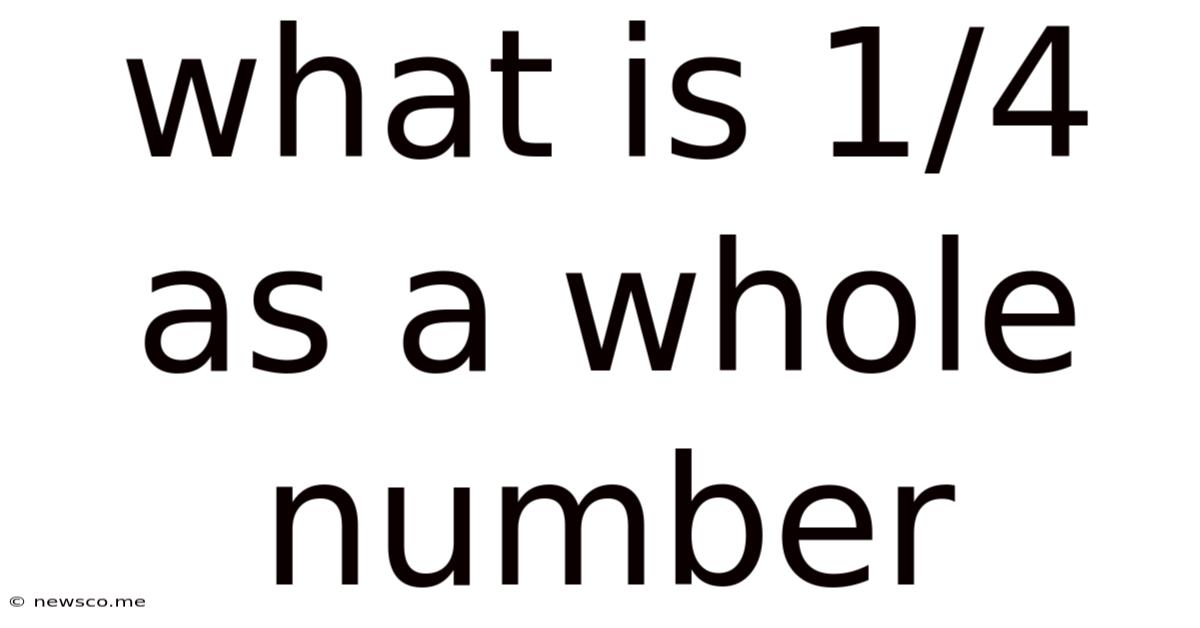What Is 1/4 As A Whole Number
News Co
Apr 22, 2025 · 5 min read

Table of Contents
What is 1/4 as a Whole Number? Understanding Fractions and Their Decimal Equivalents
The question, "What is 1/4 as a whole number?" reveals a fundamental misunderstanding of fractions. 1/4, or one-quarter, cannot be expressed as a whole number. Whole numbers are integers (0, 1, 2, 3, and so on), representing complete units. Fractions, on the other hand, represent parts of a whole. Understanding this distinction is crucial for grasping mathematical concepts beyond basic arithmetic.
This article delves into the intricacies of fractions, exploring their representation, conversion to decimals, and the inherent impossibility of expressing a proper fraction like 1/4 as a whole number. We'll also look at practical applications and common misconceptions surrounding fractions.
Understanding Fractions: Parts of a Whole
A fraction represents a portion of a whole. It's composed of two parts:
- Numerator: The top number indicates how many parts you have. In 1/4, the numerator is 1.
- Denominator: The bottom number indicates how many equal parts the whole is divided into. In 1/4, the denominator is 4.
Therefore, 1/4 means you have one out of four equal parts of a whole. Imagine a pizza cut into four slices; 1/4 represents one slice.
Representing 1/4 Visually
Visual aids are invaluable for understanding fractions. Consider these representations of 1/4:
- A Circle: Divide a circle into four equal sections. Shade one section. The shaded portion represents 1/4.
- A Square: Divide a square into four equal smaller squares. Shade one small square. This shaded area represents 1/4.
- A Bar Graph: A bar graph could have a bar that is one-fourth the length of the other bars.
Converting 1/4 to a Decimal
While 1/4 cannot be a whole number, it can be expressed as a decimal. To convert a fraction to a decimal, divide the numerator by the denominator:
1 ÷ 4 = 0.25
Therefore, 1/4 is equivalent to 0.25. This decimal representation is still a fractional value; it's not a whole number.
Why 1/4 Cannot Be a Whole Number
The very definition of a whole number excludes fractions. Whole numbers represent complete units, while fractions represent parts of units. It's analogous to trying to express half an apple as a whole number of apples – it's impossible. You can have one apple, two apples, or zero apples, but not half an apple as a whole number.
Common Misconceptions about Fractions and Whole Numbers
Many misunderstandings stem from confusing fractions with decimals or incorrectly applying whole number rules to fractions.
- Thinking Decimals are Whole Numbers: While decimals can represent whole numbers (e.g., 2.0), they can also represent fractional values (e.g., 0.25). 0.25 is not a whole number.
- Ignoring the Denominator: The denominator is crucial; it defines the size of each part. Ignoring it leads to incorrect interpretations.
- Rounding Up: Rounding a fraction up to the nearest whole number (1/4 rounded to 1) is incorrect mathematically; it changes the value.
Practical Applications of Understanding 1/4
Understanding 1/4 and other fractions is crucial in various aspects of life:
- Cooking and Baking: Recipes often use fractions to specify ingredient quantities (1/4 cup of sugar).
- Measurements: Measurements like inches and centimeters use fractions (1/4 inch).
- Finance: Calculating percentages and interest often involves fractions. A quarter of a year is 1/4 or 0.25 of a year.
- Construction: Building plans and blueprints use fractions for precise dimensions.
- Data Analysis: Statistical data frequently incorporates fractions and percentages.
Working with Fractions: Addition, Subtraction, Multiplication, and Division
Performing arithmetic operations with fractions requires understanding their properties.
- Addition and Subtraction: To add or subtract fractions, they must have the same denominator. If they don't, find a common denominator before performing the operation. For example, adding 1/4 and 1/2 requires changing 1/2 to 2/4, resulting in a sum of 3/4.
- Multiplication: Multiply the numerators together and the denominators together. For example, (1/4) * (1/2) = 1/8.
- Division: Invert the second fraction (reciprocal) and multiply. For example, (1/4) ÷ (1/2) = (1/4) * (2/1) = 2/4 = 1/2.
Beyond 1/4: Exploring Other Fractions
The concepts discussed regarding 1/4 apply to all proper fractions (fractions where the numerator is smaller than the denominator). Improper fractions (where the numerator is larger than or equal to the denominator) can be converted to mixed numbers (a whole number and a fraction). For instance, 5/4 can be expressed as 1 1/4 (one and one-quarter).
The Importance of Fractional Understanding in Advanced Mathematics
A solid understanding of fractions is fundamental for progressing in mathematics. Fractions form the basis of more advanced concepts like:
- Algebra: Solving equations often involves working with fractions.
- Calculus: Limits and derivatives involve fractional concepts.
- Statistics and Probability: Fractions are essential for representing probabilities and proportions.
Conclusion: Embrace the Fractional World
While 1/4 cannot be expressed as a whole number, its decimal equivalent (0.25) and its representation as a part of a whole are crucial for numerous mathematical applications. Mastering fractions is not just about memorizing rules; it's about understanding the concept of parts of a whole and their representation in different forms. This foundational knowledge is essential for success in various fields and everyday life. Remember, fractions aren't an obstacle; they are a powerful tool for understanding and interacting with the world around us, expressed in parts rather than wholes. A thorough understanding of fractions provides the necessary building blocks for more complex mathematical concepts and problem-solving.
Latest Posts
Related Post
Thank you for visiting our website which covers about What Is 1/4 As A Whole Number . We hope the information provided has been useful to you. Feel free to contact us if you have any questions or need further assistance. See you next time and don't miss to bookmark.